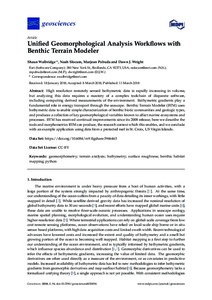Unified Geomorphological Analysis Workflows with Benthic Terrain Modeler.

Average rating
votes
Date
2018Author
Walbridge, Shaun
Slocum, Noah
Pobuda, Marjean
Wright, Dawn
Metadata
Show full item recordAbstract
High resolution remotely sensed bathymetric data is rapidly increasing in volume, but analyzing this data requires a mastery of a complex toolchain of disparate software, including computing derived measurements of the environment. Bathymetric gradients play a fundamental role in energy transport through the seascape. Benthic Terrain Modeler (BTM) uses bathymetric data to enable simple characterization of benthic biotic communities and geologic types, and produces a collection of key geomorphological variables known to affect marine ecosystems and processes. BTM has received continual improvements since its 2008 release; here we describe the tools and morphometrics BTM can produce, the research context which this enables, and we conclude with an example application using data from a protected reef in St. Croix, US Virgin Islands......
Resource URL
https://www.mdpi.com/2076-3263/8/3/94https://doi.org/10.6084/m9.figshare.5946463 (data set)
http://esriurl.com/btm (latest software version)
Journal
GeosciencesVolume
8Issue
3Page Range
24pp.Document Language
enSustainable Development Goals (SDG)
14AEssential Ocean Variables (EOV)
Hard Coral Cover and CompositionFish Abundance and Distribution
Maturity Level
TRL 2 Technology concept and/or application formulatedBest Practice Type
Best PracticeSpatial Coverage
Southwest Atlantic OceanCaribbean Sea
DOI Original
10.3390/geosciences8030094Citation
Walbridge, S.; Slocum, N.; Pobuda, M. and Wright, D.J. (2018) Unified Geomorphological Analysis Workflows with Benthic Terrain Modeler. Geosciences 8: 94, 24pp. DOI:10.3390/geosciences8030094Collections
The following license files are associated with this item:
 Repository of community practices in Ocean Research, Applications and Data/Information Management
Repository of community practices in Ocean Research, Applications and Data/Information Management
